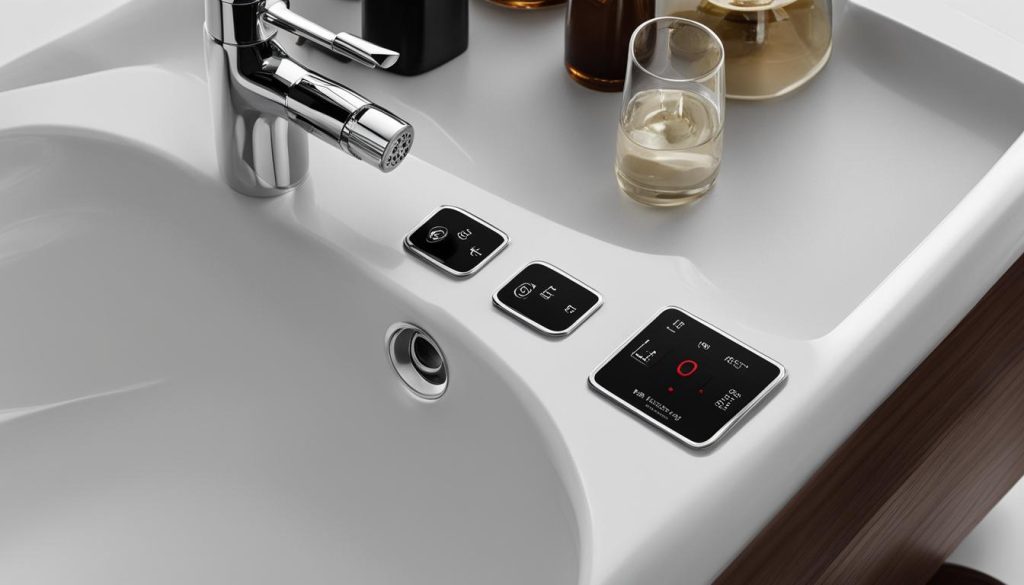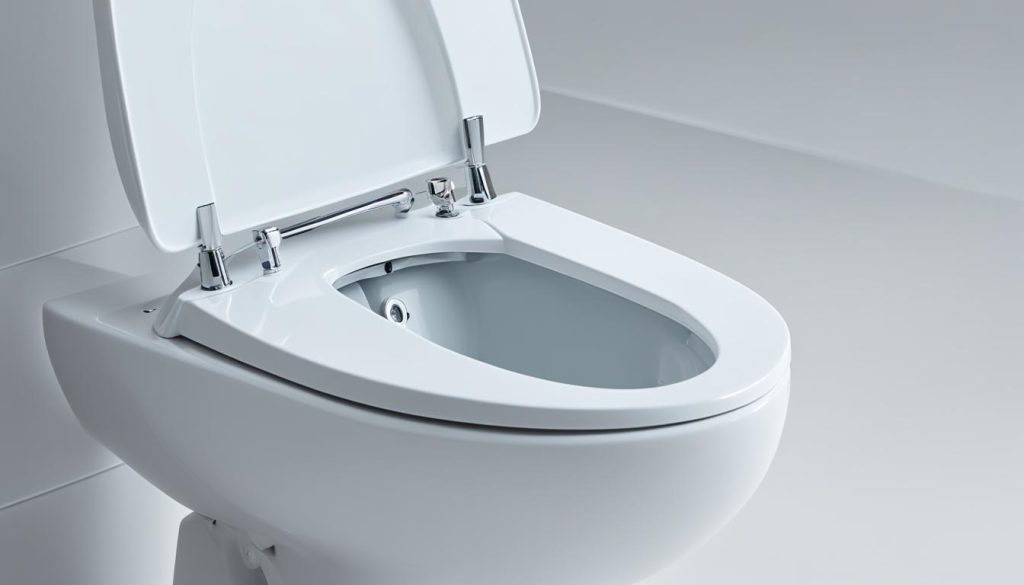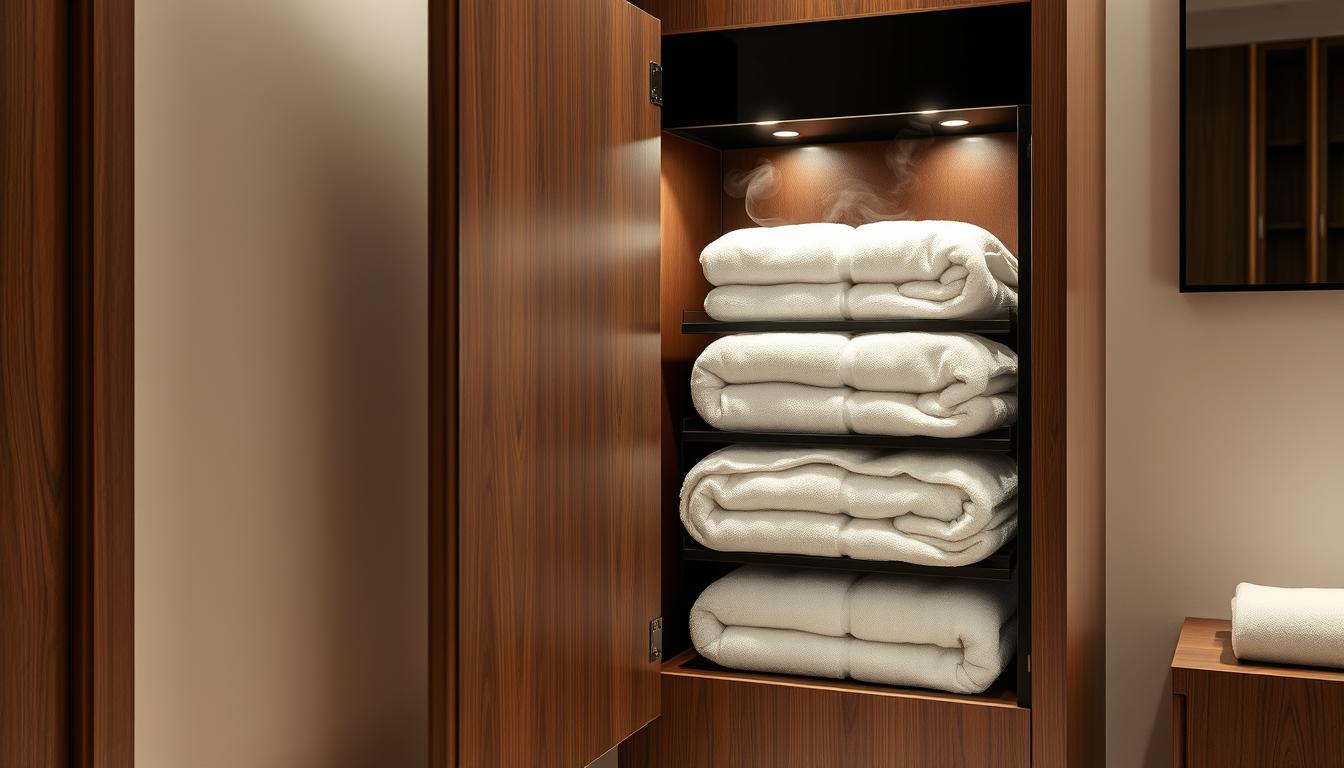If you’re experiencing issues with your bidet nozzle not extending, it can be frustrating and inconvenient. However, there are several troubleshooting steps you can take to resolve this problem and get your bidet working properly again.
First, try unplugging the bidet seat for 30 seconds and then replugging it to perform a hard reset. This simple step can often fix minor technical glitches and restore the proper functioning of the bidet nozzle.
If the nozzle still doesn’t extend after the reset, you can try triggering the bidet’s occupied seat sensor. This sensor prevents the nozzle from extending when no one is seated on the bidet seat. Depending on your bidet model, you can place a wet piece of paper on specific areas or apply pressure to certain regions of the seat to activate the sensor. This can help determine if the sensor is functioning correctly and causing the nozzle not to extend.
Another troubleshooting step is to test the remote control and auxiliary buttons. Make sure that the remote control is working properly and that the buttons are responsive. Sometimes, a malfunctioning remote control can prevent the nozzle from extending. You can cover the nozzle with a cup or your hand during the test to avoid getting sprayed.
It’s also important to check the mounting of the bidet seat. If the seat is not properly mounted onto the toilet, it may cause issues with the nozzle extending. Ensure that the seat is securely locked into the mounting bracket, and there is no movement or contact with the toilet tank.
If none of these troubleshooting steps resolve the problem, it’s recommended to contact the manufacturer for further assistance. They have expert technicians who can provide specific guidance based on your bidet model and help you address the issue.
Key Takeaways:
- Perform a hard reset by unplugging the bidet seat for 30 seconds and replugging it.
- Trigger the occupied seat sensor by placing a wet piece of paper or applying pressure on specific areas of the seat.
- Test the remote control and auxiliary buttons to ensure they are functioning properly.
- Check the mounting of the bidet seat to ensure it is securely locked in and not causing any obstruction.
- If the problem persists, contact the manufacturer for further assistance.
Troubleshooting Step 1: Unplug and Replug the Bidet Seat
If you’re facing issues with your bidet seat, such as the nozzle not extending or the seat not powering on, performing a simple reset can often solve the problem. To do this, follow these steps:
- First, unplug the bidet seat from the power source.
- Leave it unplugged for about 30 seconds to ensure all residual power is drained.
- After the 30 seconds, plug the bidet seat back into the power source.
This unplug-replug process is similar to a computer reset and can help resolve any minor issues that may have caused the bidet nozzle or seat to malfunction. Once the bidet seat is plugged back in, it should reboot and reset its internal mechanisms.
If the bidet seat still doesn’t power on or function properly after the reset, it’s important to check the electrical circuit or GFCI outlet. There is a possibility that the outlet or circuit has tripped, causing the bidet seat to not receive power. To troubleshoot this:
- Test the outlet by plugging in a working device, like a phone charger or lamp, and see if it powers on.
- If the outlet is not receiving power, check if the circuit breaker has tripped and reset it if necessary.
- If the outlet is functioning properly and the bidet seat still doesn’t work, it’s recommended to contact the manufacturer for further assistance.
Troubleshooting Step 1 Overview
| Step | Instructions |
|---|---|
| 1 | Unplug the bidet seat from the power source. |
| 2 | Leave it unplugged for about 30 seconds. |
| 3 | Plug the bidet seat back into the power source. |
| 4 | Check the GFCI outlet or electrical circuit. |
| 5 | Contact the manufacturer if the issue persists. |
Troubleshooting Step 2: Trigger the Occupied Seat Sensor
If you’re experiencing issues with your bidet seat not spraying or the nozzle not extending, it’s essential to check the functionality of the occupied seat sensor. The occupied seat sensor is a crucial component of most bidet seats, ensuring that the spray functions are only activated when someone is seated.
To test the occupied seat sensor, try using a wet piece of paper or applying pressure to specific areas of the seat, depending on the bidet model. This step helps determine if the sensor is working correctly. Different bidet models have varied sensor locations and activation methods:
- Wet paper: In some bidet models, placing a wet piece of paper in the 4-5 o’clock or 7-8 o’clock region of the seat triggers the occupied seat sensor.
- Pressure points: For other models, pressing the seat near the left rear hinge or covering the infrared sensor with a paper towel activates the sensor.
By following these instructions and performing the necessary actions, you can ensure that the occupied seat sensor is functioning properly.
Remember to refer to your bidet seat’s user manual for specific instructions on triggering the occupied seat sensor. If you encounter any issues or the sensor doesn’t respond as expected, it’s advisable to contact the manufacturer for further assistance.
Troubleshooting Step 3: Test the Remote
When dealing with bidet nozzle extension issues, it’s crucial to test the remote control. This step will help identify if the problem lies with the bidet seat or the remote control itself. Follow the instructions below to properly test the remote control.
- Start by triggering the occupied seat sensor as explained in the previous section. This ensures that the bidet is ready for testing.
- Point the remote control at the bidet seat and press the buttons to activate various features such as the warm air dryer and rear wash function.
- During the test, cover the nozzle with a cup or your hand to avoid any accidental spraying.
If the functions on the remote control work properly and the bidet seat responds accordingly, it indicates that the bidet seat is fully functioning. However, if there are any issues with the remote control not working or controlling the bidet seat, additional troubleshooting may be required.
In some cases, it may be necessary to repeat the steps while actually seated on the bidet seat. This ensures that the skin sensor is triggered, and the bidet responds appropriately to your presence. Proper positioning of the remote control is also crucial for effective operation. Make sure there are no obstacles blocking the path between the remote control and the bidet seat, and that you are within a reasonable range for the remote control to function.
If you encounter any difficulties during the testing process or if the remote control consistently does not work, it’s recommended to contact the manufacturer for further assistance.
Troubleshooting Step 4: Test the Auxiliary Buttons
If you’re experiencing issues with your bidet nozzle not extending or not working properly, it’s important to determine whether the problem lies with the remote control or the bidet seat itself. Many bidet seats come with auxiliary control panels that have basic wash functions. Testing the buttons on these panels can help narrow down the cause of the issue.
To begin troubleshooting, make sure you’ve triggered the occupied seat sensor as mentioned in the previous section. Once this is done, locate the rear wash button on the auxiliary control panel. Press this button and observe whether the bidet sprays or not.
If the bidet sprays when you press the rear wash button on the auxiliary control panel, it indicates that the remote control may be the problem.
If the bidet doesn’t spray, even when the auxiliary buttons are pressed, it suggests that there may be a more complex internal issue with the bidet seat itself. In this case, further troubleshooting or contacting the manufacturer for assistance may be necessary.
To ensure accurate results, it’s recommended to repeat the testing while seated on the bidet seat. This allows for proper triggering of the skin sensor, which can sometimes have an impact on the bidet’s functionality.
Troubleshooting Tip:
When testing the auxiliary buttons, cover the bidet nozzle with a cup or your hand to avoid getting sprayed during the process.
By following these steps and conducting a thorough test of the auxiliary buttons, you can gather valuable information to determine the root cause of the bidet nozzle not extending or not working properly.
| Auxiliary Buttons Test | Result |
|---|---|
| Bidet Nozzle Sprays | Remote control may be the problem |
| Bidet Nozzle Does Not Spray | Possible internal issue with bidet seat |
Keep in mind that this troubleshooting step is just one part of the process. If the issue persists or you need further assistance, it’s recommended to refer to the manufacturer’s guidelines or contact their customer support for expert advice.

Troubleshooting Step 5: Check the Mounting of the Bidet Seat
Properly mounting your bidet seat is essential for its optimal functionality. If the bidet seat is not securely locked into the mounting bracket, it may result in issues such as the bidet nozzle not extending and the bidet seat not working properly.
To check the mounting of your bidet seat, follow these steps:
- First, try pulling the bidet seat forward gently. If it moves or if the back of the bidet seat touches the toilet tank, it indicates that the bidet seat is not fully locked in.
- To troubleshoot this issue, slide the bidet seat off the mounting bracket by pressing and holding the seat release button. Then, slide the seat forward a few inches.
- Once the bidet seat is repositioned, test the functionality by pressing the rear wash button on the auxiliary control panel.
If the bidet sprays properly after adjusting the position of the bidet seat, it confirms that the mounting was the issue causing the bidet nozzle not to extend. However, if the bidet seat still doesn’t function correctly, additional steps like adjusting the bracket or contacting the manufacturer may be necessary.

Additional Cleaning and Maintenance Tips
Proper cleaning and maintenance are vital for preventing and addressing common bidet issues. Here are some tips to keep your bidet nozzle working smoothly and efficiently:
1. Clean with care: When cleaning your bidet seat, avoid using harsh chemicals or bleach as they can damage the plastic. Instead, opt for water or a mixture of vinegar and water. Gently scrub the nozzle with a soft toothbrush dipped in the vinegar solution to prevent clogs and maintain optimal performance.
2. Check the screen filter: Regularly inspect the screen filter for any debris or sediment buildup. If you notice any blockage, clean the filter using water and a small brush to ensure proper water flow through the nozzle.
3. Inspect water hoses: Periodically examine the water hoses connected to your bidet. If you notice any cracks, leaks, or signs of damage, it’s important to replace them promptly to prevent water leakage or interruption in nozzle functionality.
4. Consider a water filter: Installing a water filter can help remove impurities and sediment from your water supply, reducing the risk of clogs in the bidet nozzle. It’s an additional step you can take to maintain the longevity of your bidet and ensure optimal performance.
If you’ve followed these cleaning and maintenance steps and are still experiencing issues with your bidet nozzle not extending or functioning properly, it’s recommended to contact the manufacturer for further assistance. They can provide specific troubleshooting guidance and support to address the problem effectively.
FAQ
Why is my bidet nozzle not extending?
If your bidet nozzle is not extending, there are a few troubleshooting steps you can take. Start by performing a hard reset by unplugging the bidet seat for 30 seconds and then plugging it back in. If that doesn’t work, you can try triggering the occupied seat sensor by placing a wet piece of paper or applying pressure on specific areas depending on the bidet model. Testing the remote control and auxiliary buttons can also help identify the issue. Lastly, make sure that the bidet seat is properly mounted.
How do I perform a hard reset on my bidet seat?
To perform a hard reset on your bidet seat, unplug it for about 30 seconds and then plug it back in. This will restart the unit and its internal mechanisms, similar to a computer reset. If the bidet seat is not powering on or functioning properly, it’s important to check if the GFCI outlet or electrical circuit is tripped. Testing the outlet with a phone charger or lamp can help determine if it’s receiving power. If the issue persists, contacting the manufacturer for assistance is recommended.
How can I trigger the occupied seat sensor on my bidet seat?
Most bidet seats have an occupied seat sensor that prevents the seat from spraying when no one is seated. To trigger the sensor, you can use a wet piece of paper or apply pressure on specific areas of the seat depending on the bidet model. This step can help determine if the sensor is functioning properly. By following the manufacturer’s instructions, you can ensure that the occupied seat sensor is working correctly.
What should I do if the bidet nozzle still doesn’t extend after triggering the occupied seat sensor?
If the bidet nozzle still doesn’t extend after triggering the occupied seat sensor, it’s recommended to test the remote control and auxiliary buttons. Point the remote control at the seat and try activating features such as the warm air dryer and rear wash function. If the functions on the remote control work properly, it indicates that the bidet seat is fully functioning. If there are any issues, repeating the steps while seated on the seat can ensure that the skin sensor is triggered. Proper positioning of the remote control is also crucial for effective operation.
What should I do if the bidet nozzle still doesn’t extend after testing the remote control?
If the bidet nozzle still doesn’t extend after testing the remote control, it’s recommended to test the auxiliary buttons on the bidet seat. Trigger the occupied seat sensor and press the rear wash button on the auxiliary control panel. If the bidet sprays, it indicates that the remote control may be the problem. Repeat the step while seated on the seat to ensure accurate results. If the auxiliary buttons do not function even while seated, there may be a more complex internal issue that needs to be addressed.
What should I do if the bidet nozzle still doesn’t extend after testing the auxiliary buttons?
If the bidet nozzle still doesn’t extend after testing the auxiliary buttons, it’s important to check the mounting of the bidet seat. Improper mounting can cause issues with the nozzle extending. Try pulling the seat forward and see if it moves or if the back of the bidet is touching the toilet tank. If there’s any movement or contact, the seat is not fully locked in. To troubleshoot, slide the bidet seat off the bracket, press and hold the seat release button, and slide it forward a few inches. Then, test the rear wash button on the auxiliary control panel. If the bidet sprays, it indicates that the mounting was the issue. If not, adjusting the bracket or contacting the manufacturer may be necessary.
Are there any additional tips for cleaning and maintaining the bidet nozzle?
To prevent and address common bidet issues, regular cleaning and maintenance are essential. Avoid using harsh chemicals or bleach when cleaning the bidet seat, as they can damage the plastic. Instead, use water or a mixture of vinegar and water for cleaning. Cleaning the nozzle with a soft toothbrush and vinegar solution can prevent clogs and maintain optimal performance. Regularly check the screen filter for any debris and clean it if necessary. Additionally, inspecting the water hoses and replacing them if they are damaged is important for preventing leaks. Consider using a water filter to remove impurities that can clog the nozzle. If following all these steps doesn’t resolve the issue, it’s recommended to contact the manufacturer for further assistance.


